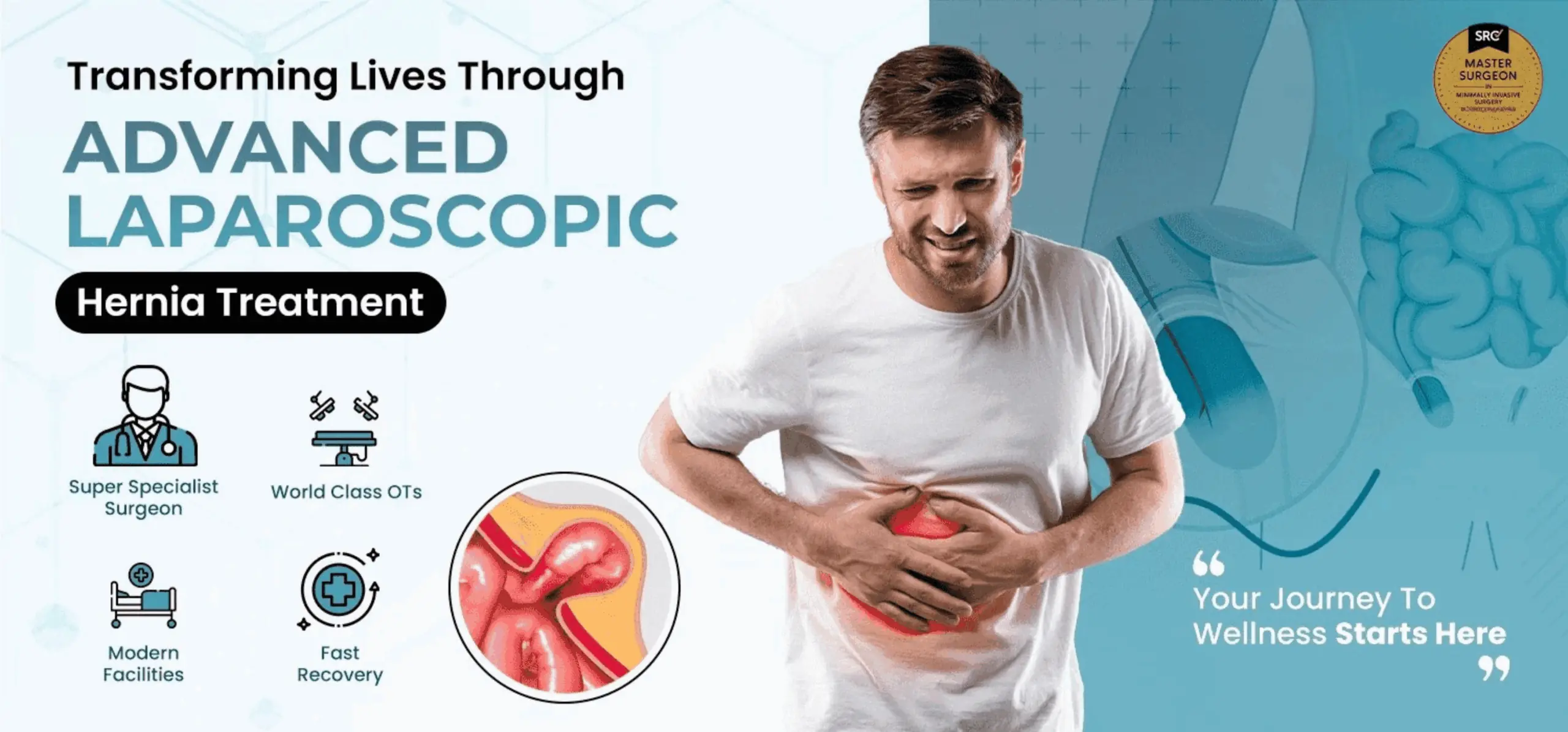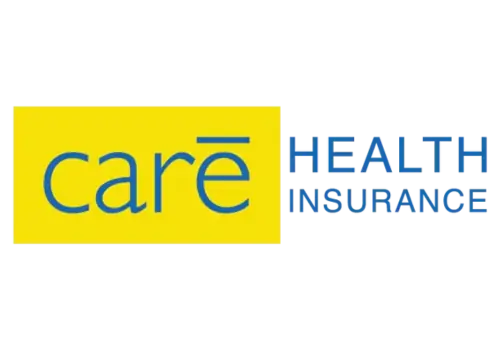
LAPAROSCOPIC HERNIA TREATMENT SURGERY
This involves very small cuts away from the hernia. Whole of the inside the abdomen can be seen by introducing a small camera scope from this hole. A hernia is closed and a special mesh is kept from inside. This leads to more secure closure of hernia as it is like repairing a tire puncture from inside. A larger mesh can be placed by this method. All hernias can be visualized easily and repaired simultaneously. There is no need for a pipe to drain fluid after surgery. The scar is much smaller. Chances of getting a hernia back are much less as compared to open hernia.
Call +91 98889-58889 For A Enquiry.

Hernia surgery In Jalandhar, Punjab
Advantages of Laparoscopic Hernia Repair over open surgery:
- Smaller cut – more cosmetic
- The bigger mesh can be inserted – so may have fewer chances of recurrence.
- Requires just three small holes for even both side groin hernias.
- Covers all kinds of holes for groin hernias as opposed to open surgery.
- Quicker recovery.
- Earlier return to work.
High Standard
Raise Your Expectations Set a benchmark of high standards. every experience meets the highest benchmarks of quality and satisfaction
Modern Technology
Our hospital has advanced technology gadgets and the best equipment in every field and modern technology paves the way to a smarter tomorrow
Committed Team
Our Dedicated And Committed hospital Team, Highly Experienced In Surgical Field Will Conduct Treatments Precisely According To Your Proper Needs.

All kind of hernia can now be treated using laparoscopy:
- Inguinal Hernias
- Ventral Hernia / Incisional Hernia
- Diaphragmatic Hernias
- Hiatus Hernia etc.
Recovery Timeline After Laparoscopic Hernia Surgery
- Discharged the same day or the next morning in most cases
- Mild pain, bloating, shoulder discomfort → controlled with medicines
- Start walking slowly the same day
- Light activities allowed (walking around the home, bathing, desk work)
- Resume light diet → focus on fluids, high fiber
- No heavy lifting, straining, or gym
- Avoid driving until pain is minimal and no strong painkillers are needed
- Most patients can return to office work / school
- Driving is usually safe
- Gentle stretching, light household tasks allowed
- Still avoid lifting more than 5 kg, strenuous exercise, or sports
- Gradually increase activity levels
- Many patients can resume exercise like cycling, jogging, or light gym work after the surgeon’s clearance
- Avoid very heavy lifting, abdominal workouts, or contact sports
- Normal activities, including heavy work, gym, and sports, are usually allowed
- The hernia site is well-healed, and the mesh is firmly integrated
- Always confirm with your surgeon before resuming very strenuous activity
Hernia Educational Videos

INGUINAL HERNIA
In this part of the intestine, fat, etc. protrudes through a weak spot in the abdominal muscles in the inguinal region (near the junction of belly and thigh). This results in a lump that can be felt initially but as it becomes bigger, it can be seen as well. It may disappear or reduce in size on lying down (as during sleep) and reappear on doing work (especially after coughing or lifting heavyweight).
There is no cure for hernia without surgery. Once detected, its recommended to get it operated as it may complicate any time into a life-threatening situations.
Symptoms
- Swelling in the groin area which becomes more obvious in standing position, especially on coughing
- A burning or aching sensation at the bulge
- Dragging sensation in the abdomen
In children
Inguinal hernias can be seen in new-borns and children due to weakness in the abdominal wall that’s present at birth especially in males. Testicles develop in abdomen and later descend into the scrotum which leads to weakness in this area. Sometimes hernia is visible only when child is crying, coughing or straining.
When to see a doctor immediately
If you know you have a hernia and you experience the following:
- Sudden severe pain
- Nausea, vomiting or both
- Fever
- The skin over the hernia turns red, purple, or dark
Causes
The cause is not always apparent but may include:
- Prolonged cough
- Prolonged constipation
- Urinary difficulty
- Strenuous activity
- Pregnancy
- Old age leading to muscle weakness
Complications
- Big hernias are difficult to repair and have a higher recurrence rate. As time passes, most hernias grow in size and become more difficult to repair and are also more prone to come back again after surgery.
- Incarcerated hernia. If the contents of the hernia become trapped, it can cause obstruction of the bowel, leading to severe pain, nausea, vomiting, etc. It may cause an inability to pass flatus.
- In extreme cases, blood flow to part of the intestine gets cut off leading to the death of that area. The intestine may get a hole here leading to the spread of dirty fluid all inside abdomen. This is a life-threatening condition and requires immediate surgery.
Prevention
A hernia is not entirely preventable but certain modifications may decrease your chances of getting one.
- Maintain a healthy weight
- High-fiber food
- Avoid lifting heavy objects
- Quit smoking – causes muscle weakness and cough
Diagnosis
Usually, a hernia can be diagnosed by a doctor by just examining the patient. In cases of doubt, a scan may be required like USG or CT or MRI.
Treatment
- A very small hernia that is not causing any trouble may be left untreated but under watchful eyes.
- Enlarging or painful hernias usually require surgery to relieve discomfort and prevent serious complications.
- There are two general types of hernia operations — open hernia repair and laparoscopic repair.
Open hernia repair
In this procedure, a cut is made in the groin area at the site of the hernia. The protruding tissue is pushed back and a mesh is kept over it to strengthen that area. The opening is then closed with stitches, staples, or surgical glue.
After the surgery, you’ll be encouraged to move about as soon as possible, but it might be several weeks before you’re able to resume normal activities.
Laparoscopy
In this minimally invasive procedure (keyhole method). There will not be any direct cut on the hernia site. Instead, there will be very small cuts elsewhere on the abdomen through which a camera and instruments will be inserted.
A much bigger mesh is employed after folding it and inserting it through a small hole. People who have laparoscopic repair might have less discomfort and scarring after surgery and a quicker return to normal activities. Having a surgeon who is very experienced in the laparoscopic procedure may reduce this risk of getting a hernia back.
Laparoscopy allows the surgeon to avoid scar tissue from an earlier hernia repair, so it might be a good choice for people whose hernias recur after open hernia surgery. It also might be a good choice for people with hernias on both sides of the body (bilateral) as both sides can be operated from the same small holes whereas in open surgery two big separate cuts will be required.
Laparoscopic surgery is also possible for small kids and helps them in recovering fast and with smaller scars.
Pain may be lesser, return to work quicker in the keyhole surgery method.
VENTRAL HERNIA
Ventral Hernias – Umbilical Hernia, Epigastric hernia, incisional hernia
Umbilical hernia – Our umbilical cord passes through the umbilicus before birth and this leaves a potentially weak area here. These are most common in infants, but they can be seen in adults as well.
Children’s umbilical hernias often close on their own in the first two years of life. Umbilical hernias in adults are more likely to need surgery.
Incisional Hernia
This occurs from the weakness caused by the cut of previous surgery. It is much more common after open surgery as compared to laparoscopic surgery.
Epigastric hernia – It is seen above the level of the umbilicus
Suprapubic hernia – This is seen below the level of the umbilicus
Symptoms
A bulge at the navel which becomes worse when the baby cries are the most common symptom in kids.
In adults, one may feel a hollow at the umbilicus or at other places on the abdomen (excluding the groin which is called an inguinal hernia). A bulge may be seen or felt there that becomes worse on coughing. In later stages bulge may just stay there all the time and may cause pain.
Complications
When the bulging abdominal tissue (intestine or fat) becomes trapped in the hernia hole, it can reduce the blood supply to the section of trapped intestine or fat and can lead to pain. If the trapped portion of the intestine is completely cut off from the blood supply (strangulated hernia), tissue death (gangrene) may occur. Infection may spread throughout the abdomen leading to a life-threatening situation.
Treatment
Most umbilical hernias in babies close on their own by age 1 or 2.
Children may require surgery if hernias:
- Are painful
- Are slightly larger than 1 to 2 centimeters in diameter
- Are large and don’t decrease in size over the first two years of life
- Don’t disappear by the age of four years
- Become trapped or block the intestine
- For adults, surgery is typically recommended soon after diagnosis to avoid possible complications. If a hernia becomes painful or shows other signs of complications, then immediate surgery is recommended.
OPEN SURGERY
The cut is made at the site of the hernia. Contents are pushed back and the hole closed with sutures. In adults, a mesh is usually placed to strengthen the abdominal wall. Open surgery involves a cut often bigger than the size of hernia to make space for the mesh. In many cases, a tube is kept to drain fluid from the wound for a few days after surgery.
Hernia Surgery Cost In Jalandhar |
|||
| Types Of Henia Surgery | Details | ||
| 1. Laparoscopic Inguinal Hernia Cost | Rs. 35,000 | ||
| 2. Laparoscopic Umbilical Hernia Cost | Rs. 40,000 | ||
| 3. Laparoscopic Incisional Hernia Cost | Rs. 40,000 | ||
| 4. Hiatus Hernia Cost | Rs. 75,000 | ||
| 5. Open Surgery Cost | Rs. 25,000 | ||
| Open | 9:30 am to 2:30 pm, 5:00 am to 6:00 pm | ||
| Working Days | Monday – Saturday | ||
| Mobile Number | +91-9888958889 | ||
Hernia Patients Testimonials

Frequent Questions - FAQ's
The most coomon medicine used by hernia patients is ampicillin and gentamicin. it should be given in the cases of gastroschisis and patients with large omphalocele
yes, but low fat and low-fat yogurt is good for hernia patient.
Light cycling
Walking
Swimming
Yoga
high fibre diet
Small and light meals
Ice pack
EXCELLENTTrustindex verifies that the original source of the review is Google. Thank you doctor Mandeep Kaur. I had a Positive result after 2 weeks of my IUI I am so happy I was waiting for so long to concive and to see 2 lines on my pregnancy test but every time that was unsuccessful but this was my first try with IUI and that’s go successfully thank you so much. 😊😊Posted onTrustindex verifies that the original source of the review is Google. Great experience with Dr. Mandeep and staff of the hospital.Posted onTrustindex verifies that the original source of the review is Google. My experience is very goodPosted onTrustindex verifies that the original source of the review is Google. Great Staff With good facilitiesPosted onTrustindex verifies that the original source of the review is Google. Thank you so much Dr mandeep from the bottom of hearts for taking such good care. Because of your professionalism and great smiles, we felt like we were in good hands and that gave us peace of mind towards the big day.Posted onTrustindex verifies that the original source of the review is Google. I got my friend’s weight loss surgery done at Star Hospital. We were impressed by Dr Ahluwalia’s clarity of thought on weight loss and Bariatric Surgery. We visited some other hospitals before and were always confused as their versions were very different but here we got answers to all our questions in a very clear way and my friend could gather courage to finally get his Bariatric Surgery done and start living a normal life again. Procedure went smooth as was told and we were out out of hospital very next day. Now we regret delaying this for years!Posted onTrustindex verifies that the original source of the review is Google. Dr Mandeep is a very hardworking and nice doctor.my result came positive and I'm very thankful to mam and all the staff members 🙏🙏










